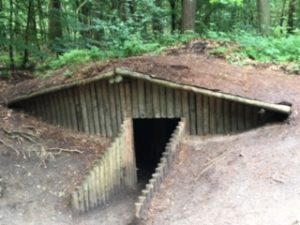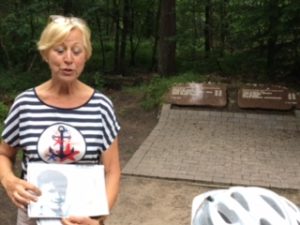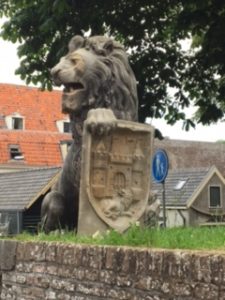
On Friday morning, we loaded our van-bus to transfer to the little village of Vierhouten, set in a large tract of woods owned by the Dutch Royal Family and open to the public much like a national forest in the US. We stopped at an Orchid Greenhouse, then checked into our hotel before re-mounting our bikes to follow a local guide into the woods to find the Hidden Village.

One of about 12 dugout shelters that provided dank living quarters for those fleeing the Germans. This one has been restored. As many as 18 people would crowd into the 16′ x 16′ room.
From 1942 until 1944, the Hidden Village served as a stop on the Dutch Resistance’s underground village, a respite for Jews, downed Allied fliers, and others sought by the Germans. Meanwhile, German garrisons occupied Vierhouten and other nearby towns. The Hidden Village consisted of 12 earthen dugout shelters, similar to prairie sod houses, scattered over a couple acres of deep forest about 4 km from Vierhouten. It housed up to 100 people at a time, and some Jewish residents lived there for months. Townspeople snuck food out to the encampment, and residents were not allowed to venture outside or cook during the day for fear they would be found by the Germans.
The village ended in 1944 due to pure happenstance. Two young boys from the Hidden Village decided to go to a spring for water during the day, against instructions. Meanwhile, two young German soldiers were out hunting for game. The boys were intercepted by the Germans, who quizzed them closely.

The memorial at the site where the 6 captured villagers were executed by the Germans. Our guide, a volunteer from a nearby village, shows a picture of a victim.
The boys, young Jews from Germany, spoke perfect German and maintained they were on holiday. Feigning interest in hunting, they asked one of the young soldiers to fire his gun. This, in fact, was an agreed-on signal to the village that they had been discovered. The young Germans returned to their garrison to report the incident, and by the time a search party discovered the village, the occupants had fled save for 6 who had decided to return for some treasured goods. The 6 were captured and later executed; all of the others successfully escaped.
The story brings into focus the Dutch’s role during WW II. The Germans invaded and overpowered the Netherlands easily in early 1940, and saw in the Dutch a people who looked, talked and acted much like them. They foresaw a vassal-state that could help staff their war effort with workers, factories, and logistics. The Dutch approach varied, but contained the usual dose of Dutch pragmatism. Some complied—a few enthusiastically, most grudgingly; many more resisted simply by refusing to follow German directions, much to the occupiers’ frustration; and many actively resisted by participating in the Dutch Resistance, which operated throughout the country.

A statue in the town of Elburg, erected after the war by a prominent Jewish resident, honoring the townspeople for their efforts to shelter Jews.
Dutch acceptance and tolerance was a trademark of Amsterdam since the Dutch Golden Age in the 17th century, and intellectuals persecuted in other European cities often sought refuge there. Russell Shorto, in his very readable book, “Amsterdam, A History of the World’s Most Liberal City”, observes that Dutch tolerance was less rooted in deep allegiance to personal rights than it was to “gedogen”, a Dutch word that he suggests means “looking the other way”, or “live and let live.” Its roots were Dutch pragmatism as much as Dutch principle, and there were many instances over the last 300 years when Dutch tolerance did not live up to its reputation. World War II was one of the most troubling times, filled with stories of surrender and complicity as well as stories of defiance and heroism. Amsterdammers both hid German targets, such as Anne Frank’s family, and gave them up to the Germans to be sent to “work camps”, which became death camps. In the countryside, the Dutch Resistance in small towns such as Vierhouten shielded many of their local citizens and shuttled fugitives to safer environs.
The Hidden Village is a story of heroism, and a few survivors still live in Amsterdam and return for an annual commemoration at the site.




